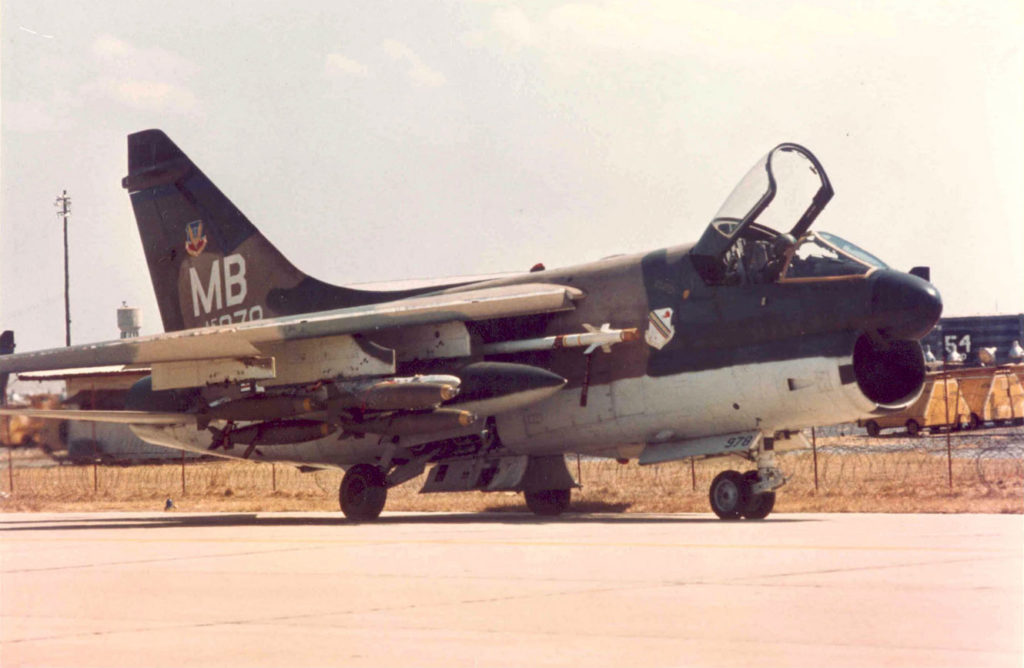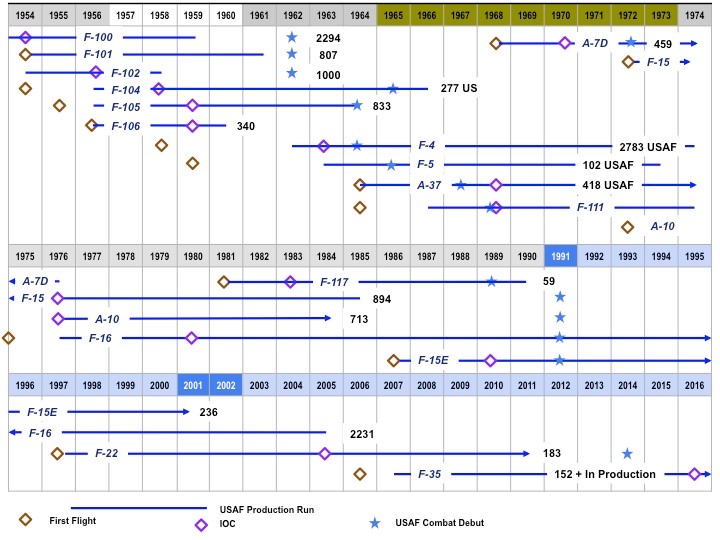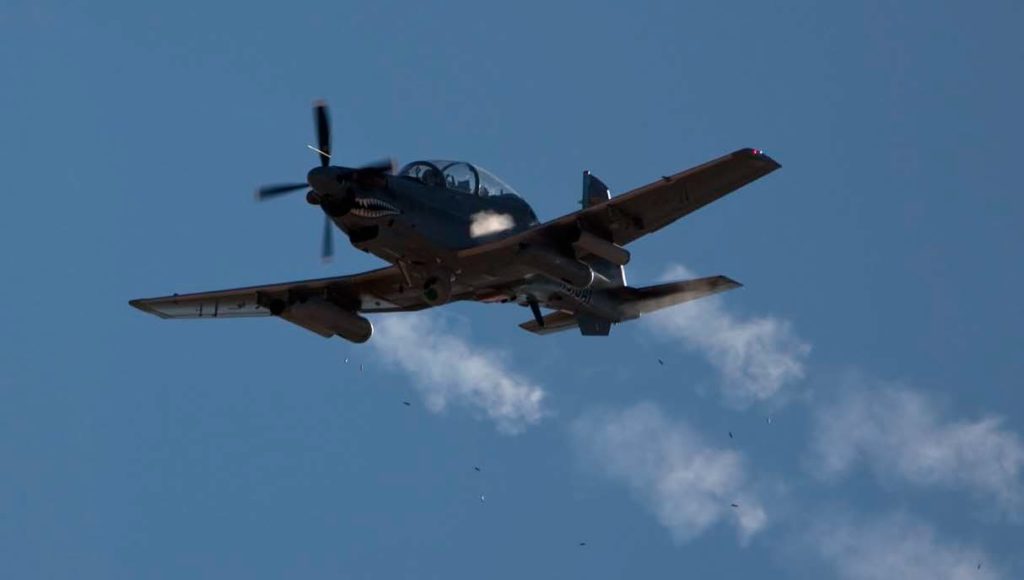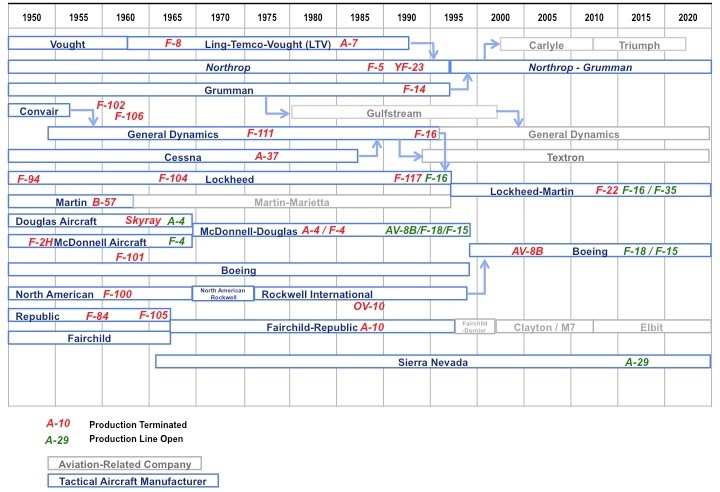

In 1961, then-Secretary of Defense Robert S. McNamara started the process that would result in the development of the Air Force’s last attack aircraft. By January 1965, the program that would become A-X split early into an interim and long-term solution — which resulted in the purchase of the A-7D and the A-10A, respectively. In the meantime, the Air Force procured surplus Navy A-1 Skyraiders, which were flown in combat by Air Force pilots as early as 1964. Spreading its attack eggs among several baskets, the Air Force also evaluated what was then called the AT-37D between 1964 and 1966. The outcome of this mishmash of attack programs was that the Air Force procured not one but four new front-line attack aircraft after 1961 — a retired Navy aircraft, a heavily modified trainer, an improved variant of the Navy’s A-7A Corsair II, and the purpose-built A-X. Three of those aircraft (A-37, A-7D and A-10) remained in service until the early 1990s, with the A-10 still in service today. RADICAL (Rapid Aircraft Development Increments Common Attack Lineage) is a bar-napkin proposal to reproduce that effort with a common technological baseline, producing a series of attack aircraft to continue and sustain a robust attack enterprise well into the 2040s. The last attack aircraft of the previous generation will provide the common lineage for follow-on efforts, ensuring that the Air Force maintains an effective and affordable capability for the modern conflicts that have proven both common and enduring.
Trapped
By historical measurements, the Air Force has all but stopped developing tactical aircraft. In 1956, the U.S. Air Force had six fighters/interceptors in production. By 1966 the number of fighter/attack aircraft in production was reduced to five, by 1976 to four, three by 1986, two by 1996, and only one in 2006. In the case of manned attack aircraft, no program to follow the A-10 was developed, instead electing to replace the A-10 with a fighter aircraft. Until Air Combat Command’s concept for OA-X was released in 2008, no follow-on attack aircraft had been contemplated since the short-lived A-7F Super Corsair was cancelled in 1990 after two prototypes had been converted.

Six decades of parallel tactical fighter/attack aircraft development for the U.S. Air Force trails off
The effect on U.S. Air Force fighter/attack strength has been substantial, with the total numbers dropping below the minimum sustainable fleet size. The Air Force’s fighter/attack fleet is now reduced to a list of undesirable superlatives. We have the smallest fleet since we became a separate service. Our average fleet age is the oldest that it has ever been. Our readiness is at the lowest levels in our history. We are in the middle of the longest period of continuous warfare since the founding of the United States. The average cost per flying hour is the highest that it has ever been. The industrial base supporting the development of combat aircraft is the narrowest since the 1920s. This is not a recipe for a healthy capability, and without revitalization of our combat aircraft development, manufacturing and procurement systems, we cannot hope to regain our former breadth of capability and may not be able to retain what we have so far managed to hold onto.
Every problem currently facing the fighter/attack fleet is directly traceable to three prevailing trends — the fleet is too small, it has been too heavily utilized for too long (with no end in sight), and we have neither replaced nor recapitalized. None of these trends are poised to reverse. With one extremely expensive fighter aircraft in production, we cannot dig ourselves out of our current hole until and unless we find a way to introduce additional new aircraft into the mix.

Partial glass-cockpit A-37B in service in Colombia in 2007 (U.S. Air Force Photo by Lt Col Mike Pietrucha)
Back to the Future
While the record of airpower application in Vietnam is decidedly mixed, there is no arguing that it was an era where the pace of airpower innovation was rapid and sustained. When faced with a shortage of attack aircraft, the Air Force procured ex-Navy Skyraider, conducted successful combat demonstrations of the A-37 and F-5C, and developed the
A-7D while waiting for the A-X program select a winner. The aircraft procured for attack missions in Vietnam were no flash-in-the-pan experiment. The A-7D, and A-37, remained in U.S. service into the 1990s. The A-10 is still in service. RADICAL is intended to set conditions to replicate that record of success by outlining a deliberate, staged development and acquisition plan intended to put a second combat aircraft into immediate production and restore conditions where at least two and more likely three fighter/attack aircraft are in production at any point over the next 20 years.
The attack aircraft envisioned under the RADICAL program are a complementary capability to the capability provided by the F-35. Over the past 25 years, the vast majority of combat missions flown by Air Force aircraft have been in permissive environments devoid of an air defense threat. Using more capable aircraft to conduct traditional attack missions has placed a very heavy burden on existing tactical aircraft — a burden that would be unnecessary if an alternative were available. With no end in sight in the struggle against violent extremist organizations, the introduction of low-cost, low-sustainment attack platforms is a necessity.
The RADICAL proposal stages aircraft in succession, with substantial opportunities for parallel development built in. By sequencing four 5-year aircraft programs, the RADICAL program is intended to meet the following objectives:
The Aircraft
The RADICAL program draft includes a sequence of aircraft designs, intended to fill specific niches in an attack aircraft portfolio that is staged in five-year blocks. Each aircraft is intended for a fleet size of at least 250 aircraft (the minimum sustainable fleet size) with a design life of at least 15 years. Each aircraft also has a different design point and a progressively later service introduction. The five-year blocks are expected to overlap so that at a minimum, there is one aircraft in production and one in development until the final years of the program. If executed as designed, 2021 will see one aircraft in service, one just beginning flight test, and two in requirements definition.
OA-X. The OA-X, defined by Air Combat Command in 2008, is a light attack turboprop intended for operations in lightly contested airspace encountered over Iraq, Afghanistan, Libya, Somalia, and Syria over the past quarter century. OA-X was intended to be non-developmental, meaning that it has some U.S. test and development or operations behind it, rather than in front of it. This attribute allows for rapid fielding in a way that an untested aircraft does not. This type is exemplified by the AT-6C Wolverine and the A-29 Super Tucano. The conversion of the T-6C into the A-10C using A-10C avionics was the conceptual starting point for the RADICAL project.
RA-X. The RC-X, which became the MC-12 Liberty, was conceived in the aftermath of the 2003/4 HORNED OWL program — an IED-hunting RC-12D. As intended, RC-X would have been armed and capable of performing armed reconnaissance, FAC(A), SCAR and TAC-A missions in addition to ISR taskings. While the MC-12 proved the utility of a light manned ISR aircraft, it did not live up to its full multirole potential. The RA-X is intended to fill that open niche, providing an attack aircraft that is larger than OA-X and capable of carrying reconfigurable sensor payloads in addition to armament up to and including 500-pound class weapons.
AF-X. The AF-X is envisioned as a rebuilt jet attack aircraft using new-build variants of a previously proven design to shorten the fielding timeline. It is intended to be able to perform air sovereignty missions as well as traditional attack missions. The unique element of an AF-X is that it would shortcut the development timeline by using a re-engineered variant of a proven design, thus eliminating the design phase of development. The genesis of this concept was Viking Air revitalization of the Twin Otter with new avionics, powerplant and structure, and Singapore’s conversion of legacy A-4s into the A-4SU Super Skyhawk.
AT-X. The AT-X is a proposed ground attack version of the Air Force’s T-X trainer. Borrowing conceptually from Northrop’s T-38/F-5 aircraft, the AT-X is intended to capitalize on the relatively high performance of T-X with the addition of weapons systems. Several manufacturers’ proposals for T-X are either derived from multirole aircraft or designed with the potential for conversion.
A-X2. Originally examined as a near-term (tails on the ramp in 5 years) attack aircraft, the A-X2 has since morphed into a dedicated replacement for the A-10. With the extended service life of the A-10, this aircraft will become the direct successor to the Hog, drawing on the three earlier attack programs in the RADICAL sequence, plus decades of experience gained with the A-10.
Common Lineage
The development of combat aircraft has been complicated by the requirement to start from scratch with a modern stores management, fire control, and systems interface capability, where commonality is very limited. Until the midlife upgrade, even different blocks of F-16 had different central computers.
The “Precision Engagement” upgrade of the A-10A into the A-10C began in 2005 and was complete by 2011. These upgrades included a modern stores management system, 1760 databus, interface provisions for modern communications and datalink, and a new central computer — the Central Interface Control Unit (CICU). Much more than a fire control upgrade, the CICU is the “brain” of an integrated weapons system that folded in the older LASTE upgrades, upgraded the cockpit display and controls, rewired the aircraft, replaced the armament control system and boosted the power system. When the T-6C was converted into the AT-6C, the avionics from the A-10C were used to convert a trainer into a warplane — bringing the weapons, sensor, and communications architecture of the A-10C into the AT-6C and proving that two aircraft could share the same fire control system. If we can do it once, we can do it again — this time with a system intended from the outset to be shared among aircraft.
Choosing a common system architecture baseline is not the limit of the common lineage. This kind of adaptation can (and has been) incorporated into aircraft already in service, providing a degree of cockpit commonality not normally seen in different models of combat aircraft. Furthermore, a common system could mean that any weapon integrated with any RADICAL aircraft is essentially integrated with any other aircraft sharing the RADICAL core, excepting only SEEK EAGLE certifications for carriage, release and jettison. This methodology keeps control of the system in Air Force hands and avoids proprietary influence by commercial interests.

AT-1, the first AT-6C prototype, fires its guns at the Goldwater Range during the OPEVAL (U.S. Air Force Photo, AATC)
The Program
Unlike previous efforts, the aircraft of the RADICAL program would be managed from a single program office. The intent of this unusual arrangement would be to allow the effective management of concurrent programs and the direct flow of capabilities between the different aircraft. It is also a deliberate attempt to control the inevitable requirements creep, which has proven to be a program-killer on more than one occasion.
Having several aircraft in differing stages of development allows for additive requirements to be shifted to where they are most appropriate. If an airframe is delayed, the production of the previous attack aircraft can be extended. If a system is delayed or added, that system can be delayed to subsequent block variants or slipped to the subsequent attack aircraft. Staged improvements may be delayed for technical, cost or integration reasons, and under this construct the additional systems may be delayed without delaying aircraft production. By slipping integration to later blocks of aircraft, delivery of early blocks can continue unabated. As later blocks came on line, older blocks might be shifted to training duties or retrofitted.

Notional Aircraft Block Groupings
For additional requirements that are not airframe specific, such as avionics, sensors, communications or weapons, the common architecture exists not only across aircraft blocks, but entire aircraft types. Thus, a system added in 2022 to Block 2 OA-X might be incorporated into Block 2.5 AF-X and also to AT-X prototypes. In all cases, the common interface requirement will allow retrofit of mature and affordable systems across the fleet (size, weight, and power permitting).
Owning the Technical Baseline
In 1973, the Air Force had awarded the contract for A-X to Fairchild to manufacture the A-10. At that time, Fairchild-Republic had not run a full production line since the termination of the F-105 almost a decade before, and the Air Force began to have serious doubts about Fairchild’s ability to meet the contract. Lt. Gen. Robert Hails, the vice-commander of Tactical Air Command, was appointed to head a committee of civilian and military personnel to review the program. The Hails report, released in late 1974, was critical of Fairchild and made a series of recommendations ranging from personnel changes to oversight and capital investment.
Today a similar effort might not be possible. Existing skill gaps within the Air Force include manufacturing/production, software, sustainment, and systems. The RADICAL proposal offers an opportunity to regain some of these skill sets by initiating a program with built-in training wheels — the off-the-shelf OA-X. By starting small and utilizing a defined fire control system architecture, we can begin to train individuals to fill the skill gaps.
In effect, the common fire control system acts as a stand-in for a standardization specification, akin to the NATO STANAG 5516, which defined implementation for the TADIL-J (Link-16) tactical datalink, now used across NATO. The key difference is that by using a common system based on existing avionics, it comes with hardware, interface, and software standards already in place. The standard will ensure forwards and backwards compatibility among attack aircraft for decades and provide a solid configuration that can be improved upon over time.
Parallel Efforts
Aircraft manufacturing is not the only aspect of the aviation enterprise that would be revitalized along with the RADICAL proposal. The existence of a constant flow of both production and developmental aircraft will necessitate an ongoing experimentation effort not seen in the Air Force since the 1970s. The discoveries made in experimentation will inform subsequent blocks of aircraft, subsequent aircraft, and as part of a constant refinement of employment tactics and techniques. Along with the airframes themselves, there are five parallel “channels” for experimentation:
A direct tie between the Attack Program office and the experimentation efforts will help ensure relevance and applicability to existing and subsequent attack aircraft. It may also be possible to tie experimentation efforts to competitive procurement of aircraft, weapons, and systems. There is precedent for this in past Air Force practice — the YA-9 prototypes were flown as test and developmental aircraft even after losing the A-X competition to the YA-10.
Industrial Base and Foreign Sales
The number of aircraft manufacturers building tactical aircraft has declined with the reduction in demand. In 1955, there were thirteen major aerospace corporations capable of manufacturing tactical aircraft; that number currently stands at three, with two others (Textron and Sierra Nevada) capable of manufacturing light attack aircraft. It is the latter that are potentially the most interesting, as both seem capable of repeating the Cessna experience with the A-37 Dragonfly. The features demanded of very high performance fighters are beyond the capabilities of most aviation companies worldwide; three American, two Chinese, two European, and one Russian. Combined, these companies number barely two-thirds of the number of U.S. producers in the middle of the last century. The features demanded by a lightweight attack aircraft are deliverable by a much wider selection of companies. Unfortunately, the United States is no longer well-supplied with industrial concerns capable of designing, manufacturing, and supporting combat aircraft, and it is clearly in the national interest to rebuild a national capability that has almost been lost. Design and production of tactical aircraft not designed for the extreme edge of high performance are within the reach of aerospace companies that have not attempted to produce the most cutting edge designs.

The shrinking U.S. industrial base capable of producing fighter / attack / interceptor aircraft
This industrial superiority was heavily exploited during the Cold War, with U.S. manufacturers both producing aircraft for foreign military assistance and licensing foreign production of combat aircraft — which were then assembled with U.S.-built engines and avionics. This was more than a healthy export market — it was also an enabler of US influence worldwide. The Air Force bought a mere 277 F-104 Starfighters of the 2578 produced — which were still rolling off the production line 20 years after the last U.S. Air Force tail was delivered. The Air Force stopped buying F-15Es and F-16s in 2001 — and those production lines have kept running entirely on foreign sales, maintaining an industrial base that would otherwise be much smaller. The clear advantage of this for the United States was that partners flying U.S.-built aircraft are likely to align closely with the United States in airpower capabilities, training methodology, and attitudes, making interoperability relatively easy.

Production runs of U.S. aircraft exported to or built by US allies. Numbers in blue are U.S. Air Force production.
Industrial base issues are not limited to the airframe itself. The RADICAL proposal has the potential to keep avionics, communications and sensor systems in a spiral development effort that can be exported to other aircraft. The UAE’s Block 60 F-16s were an example of exactly that process — built after the USAF F-16 buy terminated, the Block 60s allowed system development to continue and provided a bridge between the F-16 and the F-35 while the F-35 was in very early development.
Conclusion
The RADICAL proposal offers an opportunity to revitalize combat aircraft design, production and fielding in a manner not seen since the Vietnam War. Given critical shortages of fighter pilots, declining readiness, and a continuing campaign against violent extremists which shows no signs of abating, aggressive measures are necessary to revitalize the fighter/attack portfolio. The introduction of new attack aircraft (OA-X) followed by a series of complementary designs with a common avionics baseline offers opportunities for the Air Force’s acquisition and engineering processes as well. By entering a pre-planned, multi-aircraft program, the Air Force has an opportunity to shape the next two decades of combat aircraft production.
Col. Mike “Starbaby” Pietrucha was an instructor electronic warfare officer in the F-4G Wild Weasel and the F-15E Strike Eagle, amassing 156 combat missions over Iraq and the Former Republic of Yugoslavia and taking part in 2.5 SAM kills over 10 combat deployments. As an irregular warfare operations officer, Colonel Pietrucha has two additional combat deployments in the company of U.S. Army infantry, combat engineer, and military police units in Iraq and Afghanistan. The views expressed are those of the author and do not necessarily reflect the official policy or position of the Department of the Air Force or the U.S. government.
